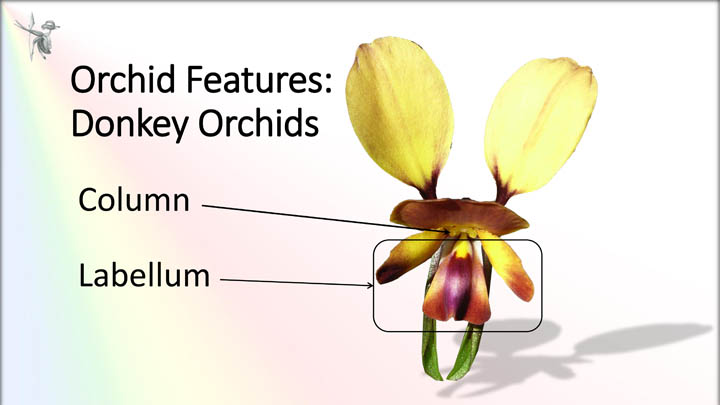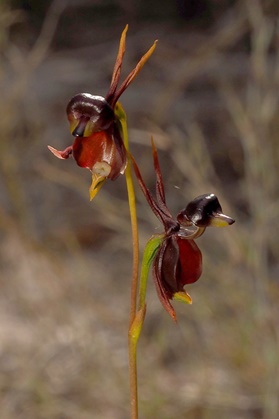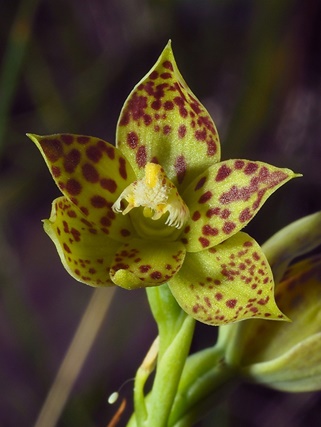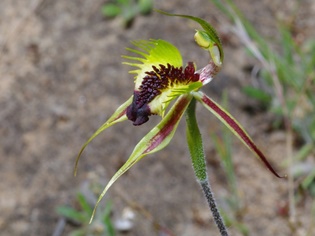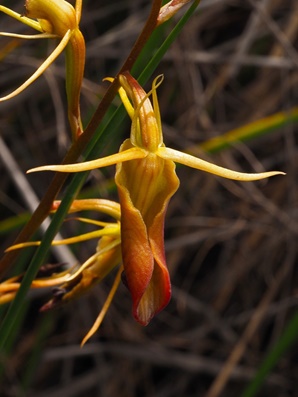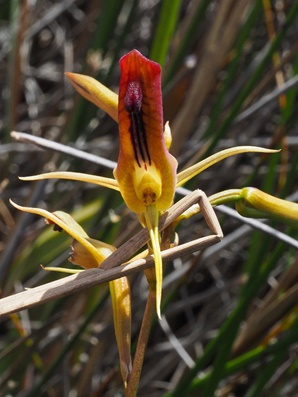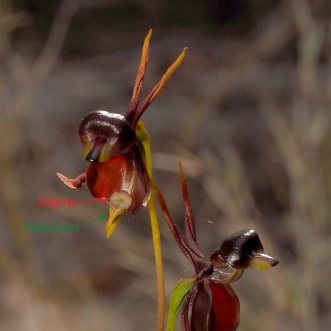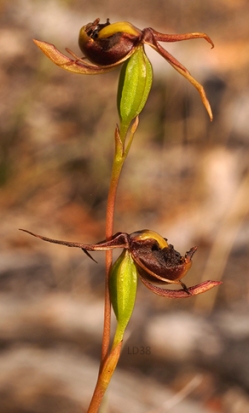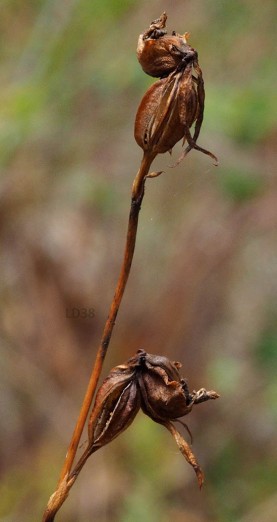This week’s blog is from the Journal of the Native Orchid Society of South Australia, Volume 42 No 8. Leo Davis has been doing a series of articles aimed at helping members learn how to identify the orchids.
This article is about Plumatichilos, one of the segregate genera of Pterostylis. It has an unique labellum which sets it apart from the other Greenhoods. Leo wrote this article soon after David Jones named them in the Australian Orchid Review. Will these names be accepted or not is a matter of waiting and seeing but it should be noted that they have been in manuscript form for many years. At the time of writing, they are not in the South Australian eflora.
Both the species discussed in Leo’s articles are from the Plumatiochilos plumosum complex or group.
Plumatichilos sp. Mallee Bearded Greenhood =Plumatichilos multisignatus
Plumatichilos sp. Woodland Bearded Greenhood = P. foliaceus
Unless otherwise noted, all images are Leo Davis.
Genus Plumatichilos.
Back in 1990 Bates & Weber placed all greenhood orchids in genus Pterostylis(1. pp118-143) where some of you and all Australian State Herbaria and certainly Janes & Duretto (3. pp260-269) would have them still be. In 2001 Szlachetko erected the genus Plumatichilos. In his Guide(4. pp286-339), Jones divided the greenhoods into 16 separate genera, these in two groups, each of eight genera. One group all have the lateral sepals directed downwards (including Bunochilus and Urochilus) and the other eight all have them directed upwards (deflexed, as in Diplodium and Pterostylis). Even those of you who reject the splitting and creation of the extra genera will concede that those placed in Plumatichilos, which have downward directed and partly fused lateral sepals (forming a synsepalum), are strikingly different in appearance to any other Pterostylis species. The most obvious distinguishing features are the unique labellum and the two openings to the galea.
I had known just two species of Plumatichilos, both of which were undescribed. I could recognise and distinguish them essentially because they grew in very different habitats and locations. I used Bates’ tag names, Mallee Bearded Greenhood (Plumatichilos sp. Mallee Bearded Greenhood) (3. pp913-4) and Woodland Plumed or Bearded Greenhood (Plumatichilos sp. Woodland Bearded Greenhood)(1. pp915-916). In recent weeks both (along with two other South Australian species) have been formally described. They are now, respectively, Plumatichilos multisignatus(5. pp33-35) (Fig. 1) and P. foliaceus(5. pp30-32) (Fig. 2). But, to a large extent, I still identify them more by the locations in which I find them than, to my eye, clearly discernable physical features.
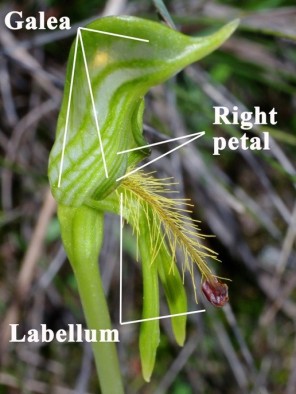 |
 |
| Fig. 1. Plumatichilos multisignatus. Monarto. Sept 10, 2012. | Fig 2. Plumatichilos foliaceus. Para Wirra. Sept 11, 2013. |
I had no idea what ‘barrier trichomes’ were but I saw that Jones listed them as the last of 13 dot pointed characters of genus Plumatichilos(5. p26). Trichome simply means a hair growing from a plant epidermis. They can be unicellar or multicellular and branched or unbranched. The ‘barrier’ refers to its capacity to block and direct a pollinating insect to an exit path that puts it in the right posture to transfer a pollinium to the stigma (sticky receptive female part of flower).
 |
Janes & Duretto, who reject the splitting of genus Pterostylis, divide it into two subgenera using the absence (subgenus Pterostylis) or the presence (subgenus Oligochaetochilus) of barrier trichomes on the column wings(3. pp262). They place what I call Plumatichilos in the section V, Catochilus, of subgenus 2 Oligochaetochilus(3. pp266), and, yes, I see your eyes glaze over. To them the Adelaide Hills ‘plum’ would be Pterostylis, subg. 2 Oligochaetochilus, Sec. V. Catochilus, species foliaceus. Learning what ‘barrier trichomes’ are had me go back searching my photo library and I found images of the barrier trichomes in Bunochilus flowers that I had not previously spotted. I have used and annotated a detail sent to me by June Niejalke. (see Fig. 3).
Fig. 3. Bunochilus prasinus. Sherlock (Type location for the species). Photo by June Niejalke. |
As with all ‘true’ Pterostylis, the dorsal sepal and the two lateral petals, of the upside down flowers, are formed into a galea or cap (Fig. 1). They are fused so closely that it can be hard to discern the join between the sepal and the comparatively small petals, especially in some less clearly striped flowers. (Figs. 1 & 2).
| The typical Pterostylis galea has a single opening but in Plumatichilos there are two, a lower one, from which the uniquely formed labellum protrudes (and through which the pollinating male gnats enter) and an upper one (through which the pollinators exit) (4. p335), guided by the barrier trichomes (Fig. 4). Through this upper opening you can observe the top of the column, including parts of it, the pollinia, the barrier trichomes, column arms and sometimes the stigma. Two crossed filaments, in front to the pollinia, are column arms.
Fig. 4. Plumatichilos foliaceus. Scott Creek C.P. Sept 2015. |
 |
 |
The labellum (the modified third petal) (Figs 1, 2 & 5) is unlike that of any other Pterostylis sp. It has a slightly flattened filament having a reddish-brown apical knob and two or three types of hairs along its length. Jones describes the labellum of P. foliaceus as having three types of hairs(5. p30). You may be able to see the short white ones (1 mm) at the base of the labellum in Fig. 5. The longer (5-7 mm) yellow ones along the most of the length of the labellum are easy to see. I am not sure that I can distinguish the shorter proximal (near point of attachment) yellow ones (1.5 mm). In P. multisignatus Jones describes just two types of labellum hairs(5. p33) with the white basal ones absent, and two sorts yellow hairs, proximal ones to 1.2 mm and longer ones 5-8 mm. To my eye, this character, two or three types of labellum hairs, is the only objective, rather than subjective , distinguishing feature between the two species that I regularly observe.
Fig. 5. Plumatichilos foliaceus. Scott Creek C.P. Sept 26, 2015. |
In Fig. 5, I think that you can see that the hairs arise, in two parallel rows, not paired, from the sides of the flattened shaft of the labellum filament.
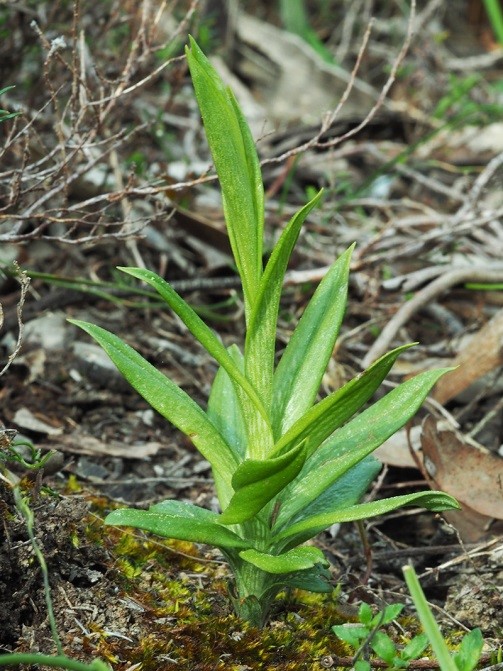 |
Fig. 6. Plumatichilos foliaceus in early bud. Scott Creek C.P. August 29, 2018.
Another generic character is ‘leaves sessile (no stems), ascending to erect, often with whitish or yellowish interveinal areas.’ (5. p26) You may need to look very closely, in Fig. 6, to see these ‘windows’, mainly at the bases of the stemless leaves. |
References:
- Bates, R.J (2011). South Australian Native Orchids, DVD Issued by the Subediting Committee (NOSSA) on behalf of the
Native Orchid Society of South Australia Incorporated.
2. Bates, R.J. & Weber. J.Z (1990). Orchids of South Australia, A. B. Caudell, Government Printer, South Australia. - Janes, J.K. & Duretto, M.F. (2010), A new classification for subtribe Pterostylidinae (Orchidaceae), reaffirming
Pterostylis in the broad sense. Australian Systematic Botany, 23, 260–269. - Jones, D.L. (2006), A Complete Guide to the Native Orchids of Australia, Reed New Holland, Australia.
5. Jones, D.L. (2018), Six new species of Plumatichilos (Orchidaceae: Pterostylidinae) fromSouth-eastern Australia and a
new species from New Zealand, Australian Orchid Review 83(4): 26-44.
Other articles about Plumatochilos can be found here and here.









